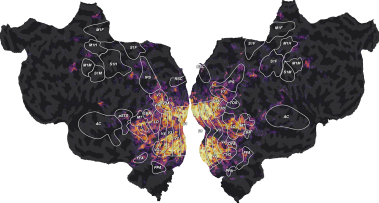Note
Go to the end to download the full example code
Extract motion energy features from the stimuli¶
This script describes how to extract motion-energy features from the stimuli.
Note
The public data set already contains precomputed motion-energy. Therefore, you do not need to run this script to fit motion-energy models in other part of this tutorial.
Motion-energy features: Motion-energy features result from filtering a video stimulus with spatio-temporal Gabor filters. A pyramid of filters is used to compute the motion-energy features at multiple spatial and temporal scales. Motion-energy features were introduced in [1].
The motion-energy extraction is performed by the package pymoten. Check the pymoten gallery of examples for visualizing motion-energy filters, and for pymoten API usage examples.
Running time¶
Extracting motion energy is a bit longer than the other examples. It typically takes a couple hours to run.
# path of the data directory
from voxelwise_tutorials.io import get_data_home
directory = get_data_home(dataset="shortclips")
print(directory)
Load the stimuli images¶
Here the data is not loaded in memory, we only take a peek at the data shape.
import os
import h5py
first_file_name = os.path.join(directory, 'stimuli', 'train_00.hdf')
print(f"Content of {first_file_name}:")
with h5py.File(first_file_name, 'r') as f:
for key in f.keys():
print(f[key])
Compute the luminance¶
The motion energy is typically not computed on RGB (color) images, but on the luminance channel of the LAB color space. To avoid loading the entire simulus array in memory, we use batches of data. These batches can be arbitrary, since the luminance is computed independently on each image.
import numpy as np
from moten.io import imagearray2luminance
from himalaya.progress_bar import bar
from voxelwise_tutorials.io import load_hdf5_array
def compute_luminance(run_name, size=(96, 96), batch_size=100):
stimuli_file = os.path.join(directory, 'stimuli', run_name)
# get the number of images in the stimuli file
with h5py.File(stimuli_file, 'r') as f:
n_images = f['stimuli'].shape[0]
# compute the luminance on each batch
luminance = np.zeros((n_images, *size))
for start in bar(range(0, n_images, batch_size),
title=f'compute_luminance({run_name})'):
# load the batch of images
batch = slice(start, start + batch_size)
images = load_hdf5_array(stimuli_file, key='stimuli', slice=batch)
# ``imagearray2luminance`` uses uint8 arrays
if images.dtype != 'uint8':
images = np.int_(np.clip(images, 0, 1) * 255).astype(np.uint8)
# convert RGB images to a single luminance channel
luminance[batch] = imagearray2luminance(images, size=size)
return luminance
luminance_train = np.concatenate(
[compute_luminance(f"train_{ii:02d}.hdf") for ii in range(12)])
luminance_test = compute_luminance("test.hdf")
Compute the motion energy¶
This is done with a MotionEnergyPyramid object of the pymoten
package. The parameters used are the one described in [1].
Here we use batches corresponding to run lengths. Indeed, motion energy is computed over multiple images, since the filters have a temporal component. Therefore, motion-energy is not independent of other images, and we cannot arbitrarily split the images.
from scipy.signal import decimate
from moten.pyramids import MotionEnergyPyramid
# fixed experiment settings
N_FRAMES_PER_SEC = 15
N_FRAMES_PER_TR = 30
N_TRS_PER_RUN = 300
def compute_motion_energy(luminance,
batch_size=N_TRS_PER_RUN * N_FRAMES_PER_TR,
noise=0.1):
n_frames, height, width = luminance.shape
# We create a pyramid instance, with the main motion-energy parameters.
pyramid = MotionEnergyPyramid(stimulus_vhsize=(height, width),
stimulus_fps=N_FRAMES_PER_SEC,
spatial_frequencies=[0, 2, 4, 8, 16, 32])
# We batch images run by run.
motion_energy = np.zeros((n_frames, pyramid.nfilters))
for ii, start in enumerate(range(0, n_frames, batch_size)):
batch = slice(start, start + batch_size)
print("run %d" % ii)
# add some noise to deal with constant black areas
luminance_batch = luminance[batch].copy()
luminance_batch += np.random.randn(*luminance_batch.shape) * noise
luminance_batch = np.clip(luminance_batch, 0, 100)
motion_energy[batch] = pyramid.project_stimulus(luminance_batch)
# decimate to the sampling frequency of fMRI responses
motion_energy_decimated = decimate(motion_energy, N_FRAMES_PER_TR,
ftype='fir', axis=0)
return motion_energy_decimated
motion_energy_train = compute_motion_energy(luminance_train)
motion_energy_test = compute_motion_energy(luminance_test)
We end this script with saving the features. These features should be approximately equal to the “motion-energy” features already precomputed in the public data set.
from voxelwise_tutorials.io import save_hdf5_dataset
features_directory = os.path.join(directory, "features")
if not os.path.exists(features_directory):
os.makedirs(features_directory)
save_hdf5_dataset(
os.path.join(features_directory, "motion_energy_recomputed.hdf"),
dataset=dict(X_train=motion_energy_train, X_test=motion_energy_test,
run_onsets=np.arange(0, 3600, 300)))
